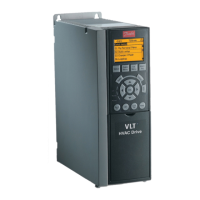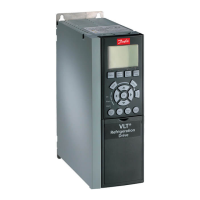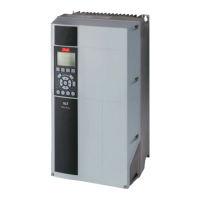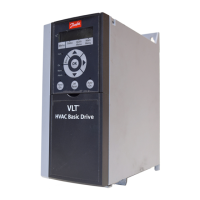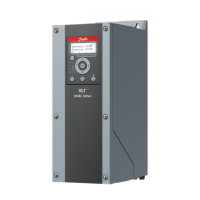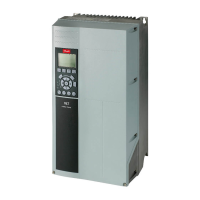4.6.1 Efficiency
Efficiency of the frequency converter (η
VLT
)
The load on the frequency converter has little effect on its
efficiency. In general, the efficiency is the same at the
rated motor frequency f
M,N
, even if the motor supplies
100% of the rated shaft torque or only 75%, i.e. in case of
part loads.
This also means that the efficiency of the frequency
converter does not change even if other U/f characteristics
are chosen.
However, the U/f characteristics influence the efficiency of
the motor.
The efficiency declines a little when the switching
frequency is set to a value of above 5 kHz. The efficiency
will also be slightly reduced if the mains voltage is 480V,
or if the motor cable is longer than 30m.
Frequency converter efficiency calculation
Calculate the efficiency of the frequency converter at
different loads based on Illustration 4.1. The factor in this
graph must be multiplied with the specific efficiency factor
listed in the specification tables:
1.0
0.99
0.98
0.97
0.96
0.95
0.93
0.92
0% 50% 100% 200%
0.94
Relative Eciency
130BB252.11
1.01
150%
% Speed
100% load 75% load 50% load 25% load
Illustration 4.1 Typical Efficiency Curves
Example: Assume a 55kW, 380-480V AC frequency
converter at 25% load at 50% speed. The graph is showing
0,97 - rated efficiency for a 55kW FC is 0.98. The actual
efficiency is then: 0.97x0.98=0.95.
Efficiency of the motor (η
MOTOR
)
The efficiency of a motor connected to the frequency
converter depends on magnetizing level. In general, the
efficiency is just as good as with mains operation. The
efficiency of the motor depends on the type of motor.
In the range of 75-100% of the rated torque, the efficiency
of the motor is practically constant, both when it is
controlled by the frequency converter and when it runs
directly on mains.
In small motors, the influence from the U/f characteristic
on efficiency is marginal. However, in motors from 11kW
and up, the advantages are significant.
In general, the switching frequency does not affect the
efficiency of small motors. Motors from 11kW and up have
their efficiency improved (1-2%). This is because the sine
shape of the motor current is almost perfect at high
switching frequency.
Efficiency of the system (η
SYSTEM
)
To calculate the system efficiency, the efficiency of the
frequency converter (η
VLT
) is multiplied by the efficiency of
the motor (η
MOTOR
):
η
SYSTEM
= η
VLT
x η
MOTOR
4.7.1
Acoustic Noise
The acoustic noise from the frequency converter comes
from three sources:
1. DC intermediate circuit coils.
2. Integral fan.
3. RFI filter choke.
The typical values measured at a distance of 1 m from the
unit:
Frame size
At reduced fan speed
(50%) [dBA] ***
Full fan speed [dBA]
A1 51 60
A2 51 60
A3 51 60
A5 54 63
B1 61 67
B2 58 70
C1 52 62
C2 55 65
C4 56 71
D1+D3 74 76
D2+D4 73 74
E1/E2 * 73 74
E1/E2 ** 82 83
F1/F2/F3/F4 78 80
* 250 kW, 380-500 VAC and 355-400 kW, 525-690 VAC only
** Remaining E1+E2 power sizes.
*** For D and E sizes, reduced fan speed is at 87%.
FC 300 Selection FC 300 Design Guide
90 MG.33.BD.02 - VLT
®
is a registered Danfoss trademark
44
